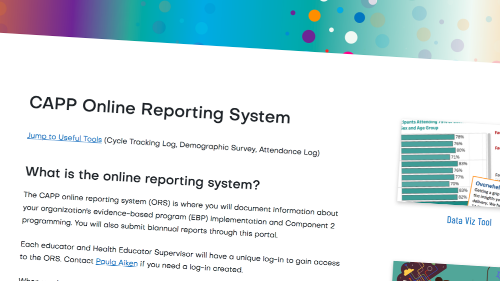EBP Fidelity and Adaptation in Your CAPP Project
If an evidence-based program (EBP) is to deliver its promised outcomes, it must be implemented in the way it was intended. We call this fidelity. And maintaining fidelity is one of the critical strategies to ensure success. At the same time, some adaptation may be necessary when implementing these programs in real-world settings. This tension between fidelity and adaptation can be confusing. On this page, we will explore ways to help program planners adapt programs in a way that will help, not harm, effectiveness.
What is Fidelity?
Fidelity means that the EBP is implemented with adherence to its core components: content (what is being communicated), pedagogy (how the content is taught), and implementation (how and where the program is delivered).
Developers base their programs on educational approaches that have been tested and found effective. Content, pedagogy, and implementation are not chosen at random or according to the developer's personal preference. The logic underlying each aspect of the program may be disrupted if the core components are changed or skipped.
What is an Adaptation?
Adaptations are any changes to the core components of an evidence-based program. While some adaptations may be helpful — such as using inclusive language, making activities more interactive, and updating statistics — others will compromise the integrity and effectiveness of the program.
| Core Component | Adaptation Examples |
|---|---|
| Content: What is being communicated? |
Adaptations might include changing the language and scenarios of role plays, updating health information, or using local statistics. |
| Pedagogy: How is the content being taught? |
Pedagogy refers to teaching strategies. Adaptations may involve structuring activities differently. Replacing a short lecture with a game that covers the same content, for example, is a change in teaching strategy. |
| Implementation: How is the program being delivered? |
The recommended group size may be from 6-12 participants. In school settings, however, group size may vary from 15-25 participants. |
Why would I want to make an adaptation?
Over the years, we have learned that some adaptations are unavoidable or necessary for a number of reasons. For example, rapidly changing youth culture may make some content seem dated and hard for participants to relate to. Programs may also need adaptations that make them more inclusive of specific populations. Additionally, sometimes an adaptation can make an activity more engaging or relevant to a particular group of participants.
What is the process for making planned adaptations?
ACT for Youth encourages providers to first understand how an activity was originally meant to be carried out before trying to adapt it. Become familiar with the theory and logic the developer used to build the curriculum, the rationale behind each activity.
Once you have identified which activities you would like to adapt, you should talk with your team and discuss how you can make those changes while maintaining the module/activity goals and objectives with the least disruption to the core elements. You will need to provide an explanation of why you want to make the adaptation when filling out the Master Adaptation List.
All adaptations in any EBP used in Component 1 programming need to be reviewed and approved by ACT for Youth. The mechanism for communicating planned adaptations is the Master Adaptation List (or "master list," for short). Originally developed by a CAPP provider and now used across the initiative, master lists:
- Give all educators the same guidance, reducing the potential need for on-the-spot adaptations
- Help educators be better prepared, which improves the quality of program delivery
- Simplify reporting in the online system (see below)
- Can be used repeatedly in a given setting
Each EBP has a designated Master Adaptation List template. You'll find master list templates and planning tools on the web page for your EBP and in the CAPP Tools and Resources Index. Submit your completed master list to the ACT for Youth provider help address for approval.
ACT for Youth will review the adaptation request and may schedule a meeting if any clarifications are needed.
I've made adaptations, now what?
Report adaptations in the Online Reporting System (ORS) when you record information about an EBP session:
The goal is to have all adaptations pre-approved, but we understand some adaptations must occur on-the-spot. Both approved and unapproved adaptations must be recorded in the ORS.

Adaptation Request Tips
- Requests to change the order of modules or "mix and match" different curricula will not be approved.
- If making multiple adaptations, be sure the delivery methods remain varied (for example, don't turn so many of the interactive games into lectures that the program becomes one long lecture).








